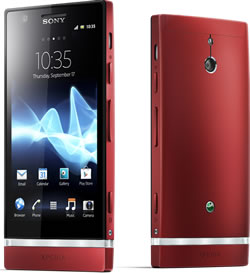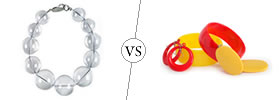Difference between Sony Xperia P and Samsung Galaxy S3
Key difference: Sony Xperia P features a 4-inch TFT touch screen that allows up to 4-touch capabilities. The screen is scratch resistant and has a shatter proof coating. The touch screen provides approximately 275 ppi pixel density along with WhiteMagic technology, which adds an extra white pixel with the already present red, blue and green. The Galaxy S3 is a slate-format multi-touch smartphone that was launched in May 2012. It has a polycarbonate plastic chassis and is available in a variety of different colors. The S3 sports a 4.8 HD Super AMOLED screen with corning gorilla glass 2. It is offered with Android v4.0.4.
 Sony is a prominent technology company and is known best for its electronics such as phones, TVs, gaming systems, etc. The constant dynamic nature of technology ensures that we always have a better and more forward technology than the one we had a month ago. The price of this dynamic technology is also high, the constant updating of technology requires people have that much cash on hand. However, many companies such as Sony know that not many people have that much cash on hand for disposal, hence has launched mid-range phones such as Xperia P that allows the people to experience the best of both worlds: technology and affordable pricing. The Xperia P was launched in May 2012 and continues to be a major player in the market.
Sony is a prominent technology company and is known best for its electronics such as phones, TVs, gaming systems, etc. The constant dynamic nature of technology ensures that we always have a better and more forward technology than the one we had a month ago. The price of this dynamic technology is also high, the constant updating of technology requires people have that much cash on hand. However, many companies such as Sony know that not many people have that much cash on hand for disposal, hence has launched mid-range phones such as Xperia P that allows the people to experience the best of both worlds: technology and affordable pricing. The Xperia P was launched in May 2012 and continues to be a major player in the market.
Sony Xperia P features a 4-inch TFT touch screen that allows up to 4-touch capabilities. The screen is scratch resistant and has a shatter proof coating, allowing the screen to endure minor scratches and everyday scuffs without sacrificing on the quality. The touch screen provides approximately 275 ppi pixel density, though not the best ppi compared to the heavy contenders but the quality of the screen is not sacrificed. This is mostly because of the company’s WhiteMagic technology, which adds an extra white pixel with the already present red, blue and green. The extra pixel generates a higher level of brightness that does not cloud the phone when using it under direct sunlight.
The phone is a little bulky in nature, but it is easy to become accustomed to when holding it for longer periods of time. The phone is also a little heavier compared to similar phones, but again not something that lets the user forget of the other great features of the phone. The phone is encased in a plastic chassis, which is quite smooth to hold but is also prone to many visible scratches and chips. The device has a clear plastic border on the front that also doubles as a cover up for the antenna. Above the plastic border reside the Home button, back button and Menu button. The power button, the volume rocker and the physical camera button is on the right side of the device, while the left sides hosts a variety of ports including the SIM card slot.
Under the hood, the device is powered by 1 GHz Dual-core processor and hosts the company’s Timescape UI. The user interface is quite smooth and does not glitch when shifting between the screens and the apps. The device runs on 1 GB RAM and comes with an internal storage capacity of 16 GB. Of the 16 GB, only 13 GB is available to the user and it is not expandable. The device houses an 8 MP Autofocus rear camera and a VGA (0.3 MP) front camera, which is a little bit of a letdown. The Exmor R technology ensures that the rear camera provides sharp, clear images, while the front camera does not live up to the same quality. Though initially powered by Android v2.3, the device is now available with Android v4.0, which no status as of yet for v4.1 upgrades. The phone also comes with additional features such as Motion gaming, MobiSystems’ OfficeSuite 5, Wi-Fi hotspot, DLNA, USB On-the-go, Native USB tethering and NFC capabilities. The Xperia P houses a non-removable 1305 mAh battery, which provides a decent battery life and lasts almost a day. With the amount of features that are offered with the phone, the price tag is expected to be quite high; however, the price is quite affordable and will not make that much of a dent in the user’s pocket.

Samsung Group is a South Korean chaebol, the largest in South Korea. A chaebol is basically a conglomerate. Samsung Electronics has become one of the key competitors in the smartphone market due to innovative technologies. The group has launched popular phones such as Samsung Galaxy S3 and Galaxy Note II.
The Galaxy S3 is a slate-format multi-touch smartphone that was launched in May 2012. It is the successor of Galaxy S2 and Galaxy S but abandons the rectangular design of the predecessors and opts for more rounded corners making it resemble the Galaxy Nexus. The S3 sports a 4.8 HD Super AMOLED screen with corning gorilla glass 2. It is offered with Android v4.0.4 (Ice Cream Sandwich) and can be upgraded to 4.1.2 (Jelly Bean). The Galaxy S III has a polycarbonate plastic chassis and is available in a variety of different colors. The S3 supports a 1.4 GHz Cortex-A9 Quad-core processor, Mali-400MP GPU and 1 GB RAM. The S3 is available with 16 or 32 GB internal storage capacity, which can be expanded up to an additional 64 GB.
The phone boasts an 8 megapixel Auto Focus camera with flash, zero shutter lag and BSI. It also supports a 1.9 megapixel secondary camera that is capable of recording HD videos @30fps. When the phone was initially launched in May, the phone was considered to have been backed with innovative features and the TouchWiz "Nature UX" GUI was considered to be advanced. The GUI also included the “Water Lux” effect which can produce water ripples on contact. The phone also offered S Voice in response to Apple’s Siri, which enabled users to verbally control 20 functions on the phone. It was effectively considered as a iPhone killer. It also received additional publicity because of the ongoing patent infringement lawsuits against Apple.
The information for the detailed table about the two phones has been taken from Sony Mobile website, expertreviews.co.uk, Samsung website and GSMArena.com.
|
|
Sony Xperia P |
Samsung S3 |
|
Launch Date |
May 2012 |
May 2012 |
|
Company |
Sony |
Samsung Electronics |
|
Size |
122 x 59.5 x 10.5 mm |
136.6 x 70.6 x 8.6 mm |
|
Display |
4-inch scratch-resistant TFT touchscreen |
4.8 inch HD Super AMOLED |
|
Screen |
960 x 540 pixels (~275 ppi pixel density), 16 million colors |
1280x720 pixels |
|
Protection |
Scratch-resistant, shatter proof sheet on mineral glass |
Corning Gorilla Glass 2 |
|
Weight |
120 grams |
133 g |
|
2G Network |
GSM GPRS/EDGE 850, 900, 1800, 1900 |
2.5G (GSM/ GPRS/ EDGE): 850/900/1800/1900 MHz |
|
3G Network |
UMTS HSPA 850, 900, 1900, 2100 |
(HSPA+ 21Mbps): 850/900/1900/2100 MHz |
|
4G Network |
N/A |
Depends on market availability. |
|
GUI |
Timescape UI |
TouchWiz "Nature UX" |
|
CPU speed |
1 GHz Dual core processor |
Quad-core 1.4 GHz Cortex-A9 |
|
GPU |
Adreno 205 |
Mali-400MP |
|
OS |
Android OS, v2.3 (Gingerbread), v4.0 (Ice Cream Sandwich), planned upgrade to v4.1 (Jelly Bean) |
Android OS, v4.0.4 (Ice Cream Sandwich), upgradeable to 4.1.2 (Jelly Bean) |
|
Chipset |
NovaThor U8500 |
Exynos 4412 Quad |
|
RAM |
1GB |
1 GB |
|
SIM Size |
microSIM |
microSIM |
|
Internal Memory |
16 GB (13 GB accessible to the user) |
16/32/64 GB (The 64GB model has been discontinued) |
|
Expandable Memory |
N/A |
microSD up to 64 GB |
|
Sensors |
Accelerometer, Proximity sensor, Ambient light sensor, Magnetometer and Gyroscope |
Accelerometer, RGB light, Digital compass, Proximity, Gyro, Barometer |
|
Connectivity |
USB High speed 2.0 and Micro USB support, WiFi and WiFi Hotspot functionality, HDMI Support, DLNA Certified, Synchronisation via Exchange ActiveSync, Google Sync and Facebook, aGPS, WebKit web browser with Pan & zoom, Bluetooth technology, Native USB tethering and NFC. |
WiFi a/b/g/n, WiFi HT40, GPS/GLONASS, NFC, Bluetooth® 4.0(LE), microUSB v2.0, USB On-the-go, wireless charging. |
|
Data |
GPRS, EDGE, WLAN, Bluetooth, NFC, USB. |
GPRS, EDGE, WLAN, Bluetooth, NFC and USB. |
|
Speed |
GSM GPRS Up to 100 kbps; GSM EDGE Up to 296 kbps; UMTS HSPA cat 6 (upload) Up to 5.6 Mbps; UMTS HSPA cat 10(download) Up to 14.4 Mbps |
HSDPA, 21 Mbps; HSUPA, 5.76 Mbps |
|
WLAN |
Wi-Fi 802.11 b/g/n, Wi-Fi hotspot, DLNA |
Wi-Fi 802.11 a/b/g/n, dual-band, DLNA, Wi-Fi Direct, Wi-Fi hotspot |
|
Bluetooth |
Bluetooth v2.1 with A2DP, EDR |
Bluetooth 4.0 with A2DP, EDR. |
|
USB |
microUSB v2.0, USB On-the-go |
micro-USB 2.0; USB On-the-go. |
|
Primary Camera |
8 MP 3264x2448 pixels rear camera |
8 megapixel Auto Focus camera with Flash & Zero Shutter Lag, BSI. |
|
Secondary Camera |
VGA front camera |
1.9 Mega pixel camera, HD recording @30fps with Zero Shutter Lag, BSI |
|
Video |
HD video recording (1080p) |
1080p@30fps, zero shutter lag. |
|
Camera Features |
|
|
|
Sound Enhancement |
xLOUD Experience Clear bass and clear stereo |
Active noise cancellation with dedicated mic. |
|
Audio supported formats |
MP3, 3GPP, MP4, SMF, WAV, OTA, Ogg vorbis |
Audio Codec: MP3, AMR-NB/WB, AAC/AAC+/eAAC+, WMA, OGG, FLAC, AC-3, apt-X. |
|
Video supported formats |
3GPP, MP4 |
Video Codec: MPEG4, H.264, H.263, DivX, DivX3.11, VC-1, VP8, WMV7/8, Sorenson Spark Recording & Playback: Full HD (1080p). |
|
Battery Capacity |
Non-removable Li-Ion 1305 mAh battery |
2100 mAh battery |
|
Talk time |
2G: 6 hours 3G: 5 hours |
2G: 21 hours 40 minutes 3G: 11 hours 40 minutes |
|
Stand-by |
2G: 470 hours 3G: 475 hours |
2G: 590 hours 3G: 790 hours |
|
Available Colors |
Black, Silver, Red |
Pebble blue, Marble white, Amber brown, Garnet red, Sapphire black, Titanium grey, La Fleur |
|
Messaging |
SMS (threaded view), MMS, Email, IM, Push Email |
SMS(threaded view), MMS, Email, Push Mail, IM, RSS |
|
Browser |
HTML5, Adobe Flash |
HTML, Adobe Flash |
|
Radio |
FM Radio with RDS |
Stereo FM radio with RDS |
|
GPS |
GPS with A-GPS support |
A-GPS support and GLONASS |
|
Java |
Java via Java MIDP emulator |
Java MIDP emulator |
|
Additional Features |
|
|
Image Courtesy: sonymobile.com, samsung.com









Add new comment